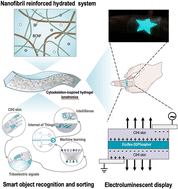Cytoskeleton-inspired hydrogel ionotronics for tactile perception and electroluminescent display in complex mechanical environments†
Abstract
The emerging applications of hydrogel ionotronics (HIs) in devices and machines require them to maintain their robustness under complex mechanical environments. Nevertheless, existing HIs still suffer from various mechanical limitations, such as the lack of balance between softness, strength, toughness, and fatigue fracture under cyclic loads. Inspired by the structure of the cytoskeleton, this study develops a sustainable HI supported by a double filamentous network. This cytoskeleton-like structure can enhance the strength of the HI by 26 times and its toughness by 3 times. It also enables HI to tolerate extreme mechanical stimuli, such as severe deformation, long-term cyclic loading, and high-frequency shearing and shocking. The advantages of these structurally- and mechanically-optimized HI devices in tactile perception and electroluminescent display, i.e., two practical applications where complex mechanical stimuli need to be sustained, are demonstrated. The findings reported in this study can inspire the design of human skin-like robust and anti-fatigue-fracture HI devices for long-term stable use.



 Please wait while we load your content...
Please wait while we load your content...